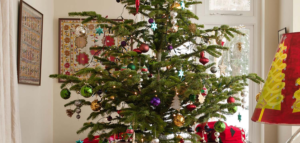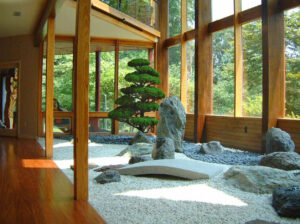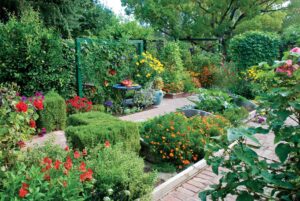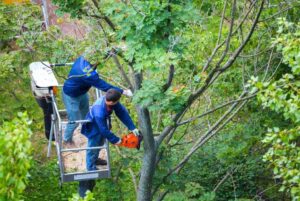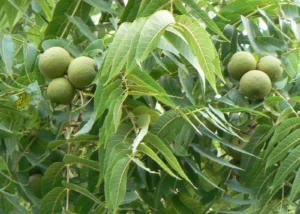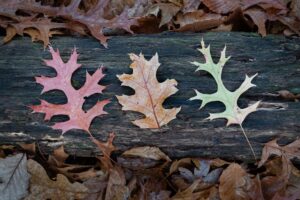Types of Juniper Shrubs for Landscape: A Complete Guide
Are you looking to enhance your landscape with versatile, hardy evergreens? Juniper shrubs might be exactly what you need. These resilient plants offer year-round interest with their diverse textures, colors, and growth habits. Whether you’re designing a rock garden, need ground cover for a slope, or want to add structure to your landscape, there’s a juniper variety perfect for your needs.
This comprehensive guide explores the most popular juniper varieties for American landscapes, proper cultivation techniques, and creative ways to incorporate these versatile shrubs into your outdoor space.
Why Choose Juniper for Your Landscape
Junipers (Juniperus spp.) have earned their place as landscape staples across the United States for good reasons. These coniferous evergreens are among the most adaptable and low-maintenance woody plants available to home gardeners and landscape professionals alike.
Benefits of Juniper Shrubs
- Drought tolerance: Once established, most junipers require minimal supplemental watering
- Cold hardiness: Many varieties thrive in USDA zones 3-9
- Versatility: Available in ground-hugging, mounding, columnar, and tree forms
- Year-round interest: Maintain their foliage through all seasons
- Pollution resistance: Thrive in urban environments and along roadways
- Erosion control: Excellent for stabilizing slopes with their extensive root systems
- Wildlife habitat: Provide shelter for birds and small mammals
According to the USDA Natural Resources Conservation Service, native juniper species play important ecological roles in many American landscapes, making them environmentally sound choices for sustainable landscaping.
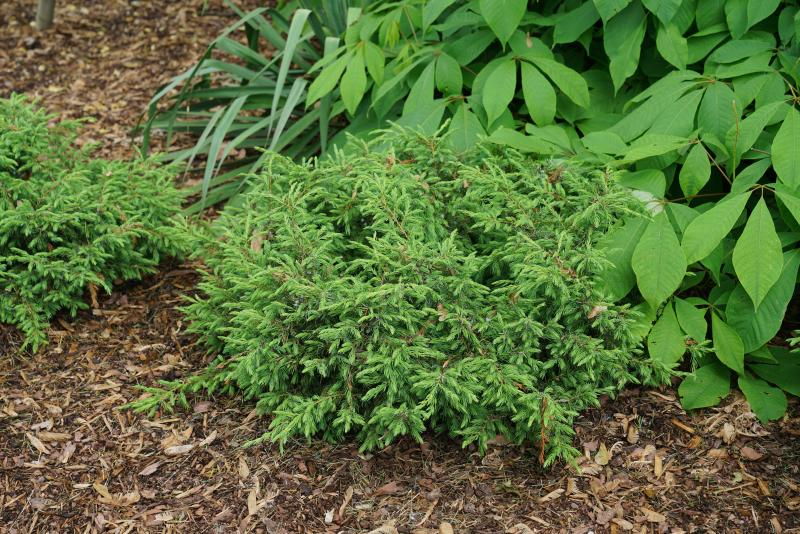
Most Popular Juniper Varieties for US Landscapes
Low-Growing and Spreading Junipers
Ground-hugging junipers are perfect for slopes, rock gardens, and areas where you need erosion control. These varieties typically reach heights of 6-18 inches while spreading 4-8 feet wide.
Blue Rug Juniper (Juniperus horizontalis ‘Wiltonii’)
One of the most popular ground cover junipers, Blue Rug features striking silvery-blue foliage that forms a dense carpet-like mat. This extremely hardy variety (zones 3-9) grows only 4-6 inches tall but can spread 6-8 feet wide. It’s excellent for controlling erosion on banks and slopes.
The blue coloration intensifies in winter, adding dramatic contrast against snow. Plant Blue Rug junipers 3-4 feet apart to allow them room to spread while eventually creating continuous coverage.
Andorra Juniper (Juniperus horizontalis ‘Plumosa’)
The Andorra juniper offers a unique color change throughout the seasons. Its feathery, bright green summer foliage transforms to a rich plum-purple in winter. Growing 12-18 inches tall with a 6-foot spread, this hardy variety (zones 3-9) works well for hillside plantings and along retaining walls.
Shore Juniper (Juniperus conferta ‘Blue Pacific’)
If you’re landscaping in coastal areas, Shore Juniper deserves consideration. This salt-tolerant variety features bright blue-green needles and grows 12 inches tall with a spread of 6-8 feet. Hardy in zones 6-9, it’s particularly well-suited for sandy soils and beachfront properties.
Medium-Sized Mounding Junipers
These versatile junipers form rounded mounds or spreading masses 2-4 feet tall, making them perfect for foundation plantings, borders, and as transitional elements in mixed shrub beds.
Sea Green Juniper (Juniperus x pfitzeriana ‘Sea Green’)
This arching, fountain-like juniper features graceful branches with bright green foliage. Growing 4-6 feet tall and wide, Sea Green junipers create elegant mounds that work beautifully as specimen plants or in groups. Hardy in zones 4-9, they maintain good color year-round without winter bronzing.
Gold Coast Juniper (Juniperus x pfitzeriana ‘Gold Coast’)
Add a splash of color to your landscape with Gold Coast juniper. This bright golden-yellow variety maintains its color throughout the year and resists scorching in full sun. Growing 2-3 feet tall with a 4-foot spread, it’s perfect for adding color contrast in evergreen groupings. Hardy in zones 4-9.
Mint Julep Juniper (Juniperus x pfitzeriana ‘Mint Julep’)
With its refreshing mint-green foliage and vase-shaped form, Mint Julep creates an elegant presence in the landscape. This variety grows 4-6 feet tall and wide, featuring arching branches that retain their bright color year-round. It performs well in zones 4-9 and makes an excellent foundation plant.
Upright and Columnar Junipers
When you need vertical accents or natural screens, columnar junipers offer architectural interest while requiring minimal footprint in the landscape.
Skyrocket Juniper (Juniperus scopulorum ‘Skyrocket’)
True to its name, Skyrocket features a narrow, columnar form that reaches for the sky. This striking variety grows 15-20 feet tall but only 2-3 feet wide, making it perfect for tight spaces where vertical emphasis is desired. Its blue-gray foliage remains attractive year-round in zones 4-9.
Taylor Juniper (Juniperus virginiana ‘Taylor’)
One of the narrowest columnar junipers available, Taylor forms a tight, slender column just 18-24 inches wide while reaching heights of 15-20 feet. This native selection of Eastern Red Cedar features blue-green foliage and exceptional cold hardiness (zones 3-9). It’s perfect for formal gardens and tight spaces needing vertical accent.
Wichita Blue Juniper (Juniperus scopulorum ‘Wichita Blue’)
This stunning pyramidal juniper features intensely silver-blue foliage that stands out in any landscape. Growing 15 feet tall and 5 feet wide, Wichita Blue makes a striking specimen plant or screen when planted in groups. Hardy in zones 3-7, it maintains excellent winter color.
Comparison Table of Popular Juniper Varieties
| Variety | Height | Spread | Form | Color | USDA Zones | Special Features |
|---|---|---|---|---|---|---|
| Blue Rug | 4-6″ | 6-8′ | Ground cover | Silvery-blue | 3-9 | Intensifies blue in winter |
| Andorra | 12-18″ | 6′ | Spreading | Green to purple | 3-9 | Winter color change |
| Shore ‘Blue Pacific’ | 12″ | 6-8′ | Ground cover | Blue-green | 6-9 | Salt tolerant |
| Sea Green | 4-6′ | 4-6′ | Mounding | Bright green | 4-9 | Arching branches |
| Gold Coast | 2-3′ | 4′ | Mounding | Golden-yellow | 4-9 | Year-round gold color |
| Mint Julep | 4-6′ | 4-6′ | Vase-shaped | Mint green | 4-9 | Bright winter color |
| Skyrocket | 15-20′ | 2-3′ | Columnar | Blue-gray | 4-9 | Very narrow habit |
| Taylor | 15-20′ | 1.5-2′ | Narrow columnar | Blue-green | 3-9 | Native selection |
| Wichita Blue | 15′ | 5′ | Pyramidal | Silver-blue | 3-7 | Intense blue color |
How to Successfully Grow Junipers

Site Selection and Preparation
Junipers thrive in full sun but will tolerate partial shade, though shade may result in thinner growth and reduced foliage color. Most importantly, junipers require excellent drainage. Before planting:
- Select a location receiving at least 6 hours of direct sunlight daily
- Test soil drainage by digging a 12-inch hole and filling it with water
- If water hasn’t drained within 2-3 hours, amend the soil with coarse sand and organic matter, or consider raised planting
- Adjust soil pH if necessary—junipers prefer slightly acidic to neutral conditions (pH 5.5-7.0)
According to the USDA Forest Service, native junipers have adapted to a wide range of soil conditions but universally require good drainage to prevent root rot issues.
Planting Techniques
Fall is generally the best time to plant junipers in most regions, though spring planting works well in colder northern areas. To ensure successful establishment:
- Dig a planting hole twice as wide as the root ball but no deeper
- Remove the plant from its container and gently loosen the root ball, especially if roots are circling
- Place the juniper in the hole with the top of the root ball level with or slightly above the surrounding soil
- Backfill with native soil, avoiding excessive amendments
- Create a slight basin around the planting area to collect water
- Apply 2-3 inches of mulch, keeping it several inches away from the trunk
Watering and Maintenance
While established junipers are drought-tolerant, proper watering during the first year is crucial for developing strong root systems:
- Water deeply once weekly during the first growing season
- Increase frequency during extreme heat or drought periods
- Reduce watering in fall to help plants harden off before winter
- After the first year, supplement rainfall only during extended drought
Junipers generally require minimal fertilization. If growth seems slow or foliage lacks vigor, apply a balanced slow-release fertilizer formulated for evergreens in early spring.
Pruning Guidelines
One of the benefits of selecting the right juniper variety is minimal pruning requirements. However, occasional pruning helps maintain shape and plant health:
- Prune lightly in late winter or early spring before new growth emerges
- Remove dead or damaged branches anytime
- For spreading varieties, trim back any overly vigorous shoots to maintain desired form
- Never cut back to bare wood as junipers rarely sprout from old wood
- Use sharp, clean pruning tools to prevent disease transmission
Common Problems and Solutions
Pest Management
While generally resistant to many pests, junipers can occasionally face challenges:
Spider Mites: These tiny pests can cause foliage to appear dusty, stippled, or yellowish. Control with strong water sprays or horticultural oils.
Bagworms: Watch for small cone-shaped bags hanging from branches. Remove by hand or treat with Bacillus thuringiensis when larvae are young.
Juniper Scale: These immobile insects appear as small bumps on stems and can be controlled with horticultural oil applications during the dormant season.
According to the USDA Agricultural Research Service, promoting biodiversity in your landscape can help keep juniper pests in check naturally by attracting beneficial predatory insects.
Disease Prevention
The most common diseases affecting junipers include:
Phomopsis Tip Blight: This fungal disease causes branch tips to turn brown and die back. Improve air circulation, avoid overhead watering, and prune affected areas.
Cedar-Apple Rust: This fungal disease requires both junipers and apple family plants to complete its life cycle. Orange gelatinous galls form on junipers in spring. Consider resistant varieties if this is a concern in your area.
Root Rot: Primarily caused by overwatering or poor drainage. Prevention through proper site selection and drainage is most effective.
Creative Landscape Uses for Junipers
Foundation Plantings
Junipers make excellent foundation plants, softening the transition between your home and the surrounding landscape:
- Use low-growing varieties under windows
- Plant medium-sized selections at corners
- Combine with broadleaf evergreens and flowering shrubs for textural contrast
Rock Gardens and Slopes
The shallow, spreading root systems of many junipers make them ideal for stabilizing slopes and enhancing rock gardens:
- Place spreading varieties to cascade over stone walls or large boulders
- Combine blue-foliaged junipers with silver-leaved perennials for a drought-tolerant display
- Interplant with spring-flowering bulbs for seasonal interest
Modern Minimalist Landscapes
For contemporary landscape designs emphasizing clean lines and architectural forms:
- Plant columnar varieties in series to create living walls or privacy screens
- Use ground-hugging varieties as living mulch around specimen trees
- Create geometric patterns with contrasting foliage colors
Wildlife-Friendly Landscaping
If attracting wildlife is among your goals, junipers offer significant benefits:
- The dense foliage provides nesting sites and cover for birds
- Female plants produce berries that attract cedar waxwings and other bird species
- The protective structure offers shelter for beneficial insects during winter
The National Wildlife Federation recognizes the value of native juniper species in creating habitat gardens that support local ecosystems.
Regional Considerations for Juniper Selection
Cold Northern Climates (Zones 3-5)
In areas with harsh winters, focus on cold-hardy varieties:
- Eastern Red Cedar selections (Juniperus virginiana)
- Rocky Mountain Juniper varieties (Juniperus scopulorum)
- Common Juniper cultivars (Juniperus communis)
These species have evolved to withstand extreme temperature fluctuations and winter dessication.
Hot Southern Regions (Zones 8-9)
For landscapes facing intense summer heat and humidity:
- Chinese Juniper varieties (Juniperus chinensis)
- Shore Juniper selections (Juniperus conferta)
- Hollywood Juniper (Juniperus chinensis ‘Torulosa’)
These varieties demonstrate better resistance to fungal issues that can develop in humid conditions.
Arid Western States
In regions with low rainfall and high alkalinity:
- Utah Juniper (Juniperus osteosperma)
- Alligator Juniper (Juniperus deppeana)
- One-seed Juniper (Juniperus monosperma)
These native Western species have adapted to drought conditions and alkaline soils common throughout the American West.
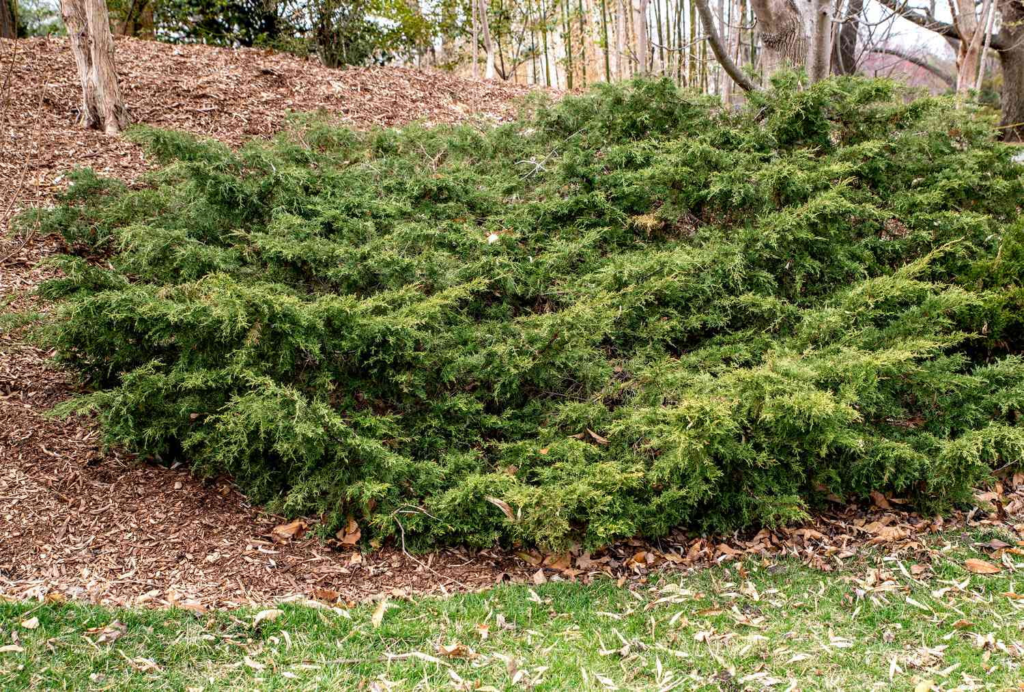
Sustainability Aspects of Juniper Landscaping
Incorporating junipers into your landscape contributes to sustainability in several ways:
Water Conservation
With increasing water restrictions across many regions, junipers’ drought tolerance makes them environmentally responsible choices. According to the EPA WaterSense program, replacing water-hungry landscape plants with adapted species like junipers can reduce outdoor water use by 20-50%.
Reduced Chemical Inputs
The natural resistance of junipers to many pests and diseases means fewer chemical interventions are needed to maintain attractive plantings. This benefits beneficial insects and reduces chemical runoff into local waterways.
Carbon Sequestration
As evergreen woody plants, junipers continuously capture and store carbon dioxide year-round, helping to offset greenhouse gas emissions in a small but meaningful way.
Conclusion
Juniper shrubs offer remarkable versatility for American landscapes, combining aesthetic appeal with practical benefits like low maintenance, drought tolerance, and year-round interest. By selecting varieties appropriate for your specific growing conditions and landscape goals, you can enjoy these resilient evergreens for decades with minimal intervention.
Whether you’re creating a water-wise garden in the Southwest, a wildlife sanctuary in the Midwest, or a structured modern landscape in the Northeast, there’s a juniper variety perfectly suited to your vision. Their adaptability across hardiness zones and landscape styles makes them valuable components of sustainable, beautiful outdoor spaces throughout the country.
As you plan your next landscape project, consider the diverse forms, colors, and textures junipers offer. From ground-hugging blue carpets to towering green sentinels, these versatile conifers deserve a place in your garden design toolkit.

